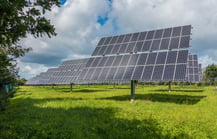
California’s Department of Toxic Substances Control (DTSC) established waste management rules for solar photovoltaic (PV) modules, to become effective on January 1, 2021. These rules are adopted under the state Hazardous Waste Control Law (HWCL), applying “universal waste” authority permissible under the federal Resource Conservation and Recovery Act (RCRA) and Environmental Protection Agency (EPA) RCRA regulations. EPA defines five universal waste categories, and also allows states to define additional categories (I wrote about this HERE). The remainder of today’s blog summarizes these universal waste PV requirements (which include dozens of revisions to proposed state rules I discussed HERE).
Which PV Wastes Are Covered?
DTSC’s general justification for regulating waste PV modules is the likelihood that the wastes will exhibit the toxicity characteristic, because of heavy metals such as cadmium, copper, lead, or selenium. DTSC is adding the following definitions covering photovoltaic equipment including actual PV cells and peripherals:
“’Photovoltaic cell’ means a specialized semiconductor diode designed to convert solar radiation into electrical energy. Photovoltaic cells are individual cells that are not electrically connected or an integral part of photovoltaic modules that are electrically connected. Photovoltaic cells are also commonly referred to as solar cells. Photovoltaic cells are managed as photovoltaic modules.
‘Photovoltaic module‘ means a device consisting of or containing one or more electrically connected photovoltaic cells that are designed to convert solar radiation into electrical energy. Photovoltaic module includes integrated components that cannot be separated without breaking the photovoltaic module glass. Examples of integrated components include, but not limited to, protective glass, conductive metal contact, metal framing the photovoltaic cells, housing or pocket holding the photovoltaic cells/modules, and top and back layer. Photovoltaic modules are composed of, but are not limited to, monocrystalline silicon, polycrystalline silicon, amorphous silicon, cadmium telluride, copper indium gallium selenide, and gallium indium phosphide/gallium arsenide/gallium, and perovskite. Photovoltaic modules are also commonly referred to as photovoltaic panels or solar panels. Photovoltaic cells that are not electrically connected are managed as photovoltaic modules
‘Photovoltaic panel see ‘photovoltaic module.’
‘Photovoltaic system’ means a set of components consisting of one or more photovoltaic modules and includes any ancillary components that can be manually separated without breaking the photovoltaic module glass such as, but not limited to, metal frames used to support the photovoltaic module, connectors, junction boxes, batteries, inverters, wires, and cables that are connected to the photovoltaic module. Photovoltaic systems are also commonly referred to as solar systems.”
However, DTSC excludes the following:
-
-
Not yet “wastes” as defined under HWCL.
-
Do not exhibit a characteristic of a hazardous waste (i.e., corrosivity, ignitability, reactivity, or toxicity) (these are not hazardous wastes).
-
Exhibit any characteristic of a hazardous waste other than toxicity (which must be managed as hazardous wastes, not universal wastes).
-
Destined for recycling (or are recycled) by being “used in a manner constituting disposal” (which must be managed as hazardous wastes).
-
Destined for disposal at a permitted hazardous waste disposal facility (which must be managed as hazardous wastes, not universal wastes).
-
Managed as hazardous wastes.
-
Were previously identified as waste, but are no longer identified as a waste (e.g., discarded PV modules that are refurbished and are returned to service).
-
Are integrated into the structure of electronic devices (e.g., calculators) (these are subject to state e-waste requirements).
-
What Requirements will California apply?
Universal waste management requirements begin with “handlers” – analogous to hazardous waste “generators.” Related requirements also apply to universal waste transporters, and to destination facilities where wastes are managed offsite. California interpolates requirements for PV cells and modules into the state’s existing universal waste regulations (which are consistent with the national requirements I summarized in my prior blog). Note that no facilities have yet received permits for offsite management of PV universal wastes, but DTSC anticipates that such permits will be sought in response to the opportunities created by these new provisions.
- What onsite management standards will apply?
Universal waste handlers are subject to onsite management requirements, applicable after generation but before the wastes are shipped offsite. Requirements include:
-
-
Do not accumulate universal waste onsite for longer than 1 year, unless necessary to facilitate proper recovery, treatment or disposal.
-
Label universal waste or its container to identify the type of waste.
-
Demonstrate when accumulation begins by one of the following methods:
-
Label or mark the universal waste container with the accumulation start date.
-
Mark each universal waste item with the date it became waste.
-
-
Maintain an inventory system that identifies the first date an item in a group of waste became a waste.
-
Place the wastes in a specific accumulation area with a set date.
-
Any other method that clearly demonstrates the accumulation time.
-
- What Notifications Will Be Required?
A handler that generates 5,000 kg or more in a year must provide annual reports to DTSC with specified information. A handler that accepts universal waste PV from another handler (which can include other organizations, or other facilities of the same organization) must also provide DTSC with notifications.
- What Standards Will Apply To Transportation For Offsite Management?
Shipments of universal waste PVs offsite do not require use of Uniform Hazardous Waste Manifests, but must meet tracking requirements:
-
-
Universal waste shipments must be only to another universal waste handler, an appropriate destination facility, or a foreign destination.
-
Universal wastes that meet Department of Transportation (DOT) definitions of “hazardous materials” must be shipped in compliance with DOT hazardous materials shipping standards.
-
Shippers must ensure that the receiving handler agrees to receive a shipment before initiating a shipment.
-
If a universal waste shipment is rejected by the destination facility, the originating handler must either receive the waste back, or agree with the receiving facility on a new destination.
-
A destination facility that rejects a shipment must inform the originating facility of the rejection and either send the waste back or agree with the sender on a new destination facility for the waste.
-
A universal waste handler that receives a shipment that includes hazardous waste must inform DTSC, and provide the name and address of the originator of the shipment.
-
Exports of universal waste are subject to the same types of international consent requirements as are hazardous waste exports.
-
Handlers, transporters, and destination facilities must retain required records of each shipment.
-
What’s Next?
These requirements take effect in California on January 1, 2021. Organizations that do not do business in California will not be directly affected, but should consider these rules anyway. As installations of PV modules increasing throughout the country, the relative importance of the waste stream will grow. Accordingly, California’s rules would provide ready models for other jurisdictions to follow.
Self-Assessment Checklist
Does the organization manufacture or use photovoltaic modules?
If so, does the organization have procedures in place for managing waste PV modules?
If so, do the procedures include provisions comparable to universal waste requirements?
Where Do I Go For More Information?
About the Author
 Jon Elliott is President of Touchstone Environmental and has been a major contributor to STP’s product range for over 30 years.
Jon Elliott is President of Touchstone Environmental and has been a major contributor to STP’s product range for over 30 years.
Mr. Elliott has a diverse educational background. In addition to his Juris Doctor (University of California, Boalt Hall School of Law, 1981), he holds a Master of Public Policy (Goldman School of Public Policy [GSPP], UC Berkeley, 1980), and a Bachelor of Science in Mechanical Engineering (Princeton University, 1977).
Mr. Elliott is active in professional and community organizations. In addition, he is a past chairman of the Board of Directors of the GSPP Alumni Association, and past member of the Executive Committee of the State Bar of California's Environmental Law Section (including past chair of its Legislative Committee).
You may contact Mr. Elliott directly at: tei@ix.netcom.com
Image by Sebastian Ganso from Pixabay

